One of the best rules of thumb is to keep your tent cleaned at all the times, especially after taking your summer outdoor adventure. Cleaning a tent not only keeps it user-friendly and fresh-smelling but lengthens its durability. So the more you clean it, it’s the more you preserve its quality, and thus you will be preserving your outdoor camping asset. But, bear in mind that cleaning a tent is not as easy as machine washing your fashion or winter clothes. Some tents end up being damaged by the attempt to wash them cluelessly. In this article, we’ve endeavored to share with you our expertise on how to clean a tent efficiently.
In addition to equipping you with skills on how to clean your tent, we’ve extended our generosity to discussing the best care techniques that are needed to make the tent durable. We are aware that cleaning alone is insufficient to ensure that the tent is well maintained. One needs to know how to store the tent or care for it during any use in order to limit the need to clean it frequently. Our main focus is, however, on cleaning the camping tents.

The tent cleaning techniques that we’ve discussed apply to all the brands of camping tents. Majority of tents, irrespective of the brands, predominantly use either the nylon or polyester as their fabric materials. So it should be easy to care for such fabrics and to clean them successfully. You’ll be lucky if the manufacturer of your tent has provided some user manual giving instructions on how to care for it. If not, then read through our tent care and cleaning tips below.
How to clean the tent?
Before washing off the stains, mold, and the mildew microorganisms that have infested on your tent, you need to procure your cleaning materials. These include the following:
- Warm/cold water
- Garden hose or shower head
- Vacuum cleaner with brush attachments
- White wine vinegar
- Soft scrub brush
- Spray bottles
- Mild soap and cloth
- Dustpan and dust-buster
- Broom and paper towels
- Sufficient water to rinse
With these basic cleaning materials, you will be able to thoroughly and efficiently clean your tent. But the first warning that we have to issue is that never use the machine to wash your tent because you will compromise the quality of its fabric coatings. The hair dryer or the machine dryer should not be used as well as the heat might also damage the fabric coatings.
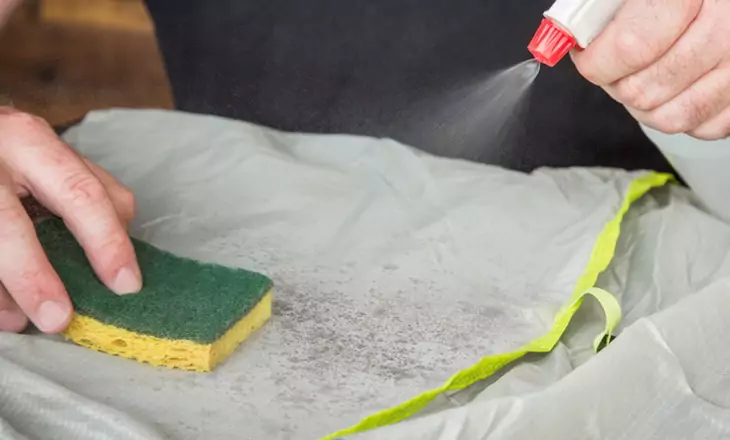
All you need is a hand-washing ability to remove even the toughest stains on your tent. There could be two ways of washing your tent; one being to spot the dirt and then clean the spots accordingly, and the other being to wash the entire tent by submerging it in water or by sprinkling more water on it. But beware of submerging the tent longer than it is needed as the waterproof coatings on the fabric may start to peel off.
So far you’ve noticed how demanding it is to clean a tent. We’ve demystified the process on how to wash a tent efficiently using your hands below:
- Pitch and taut the tent → It is important that you stretch the tent to iron out the wrinkles for an effective removal of the toughest stains. You can also drape it over a fence, if deemed necessary. With either method, just avoid overly exposing it to too much UV rays as they may damage the fabric regardless of the fly material used. But usually, the polyester rainfly can protect the tent against the UV rays better than the nylon rainfly does. So, pitch the tent under shadows to avoid these UV rays and in good weather conditions.
- Remove the dust and debris → Before attempting to use water to wash the tent, use the broom and the vacuum cleaner to remove the dust and other debris inside and outside the tent. Even the soft scrub brush can be used. This will help reveal other stains such as mosquito blood or bird droppings from the dust. Do this after pitching your tent on a clean surface.
- Hand wash the tent → use a soft scrub brush or sponge with cold water and a mild soap that is non-detergent to clean the tent from the inside to the outside. Clean the rainfly separately. You can simply spread the rain fly on a grass for effective cleaning or drape it over some shrubs. When hand washing the tent, avoid a vigorous scrubbing because it might peel off the waterproof coating, and that could be costly to re-coat it. Instead, some alcohol-based solutions can be used for the targeted tough stains. But, do not use household cleaning solutions such as the chlorine/iodine bleach and the dishwashing liquid as they can compromise the quality of your DWR (Durable Water Repellent) coatings.
- Clean the poles and the zippers → the zippers and the poles need special attention when cleaning. For instance, there are outdoor formulated lubricants that can be applied on them to clean off the dirt. Attempting to scrub the zippers with the brush may prompt a vigorous scrubbing, which may compromise the waterproof coating as well.
- Dry the tent → Here comes the important step of drying your tent. Keep in mind that mold and mildew are likely to grow spontaneously if the tent is stored while damp and wet after cleaning it. The resulting funky odor will not be tolerated the next time you unfurl it at your campsite. So, to avoid that, leave your tent taut and pitched in direct sunlight for it to dry. But, before that, use a regular garden hose or shower head to sprinkle water over the tent so that the soap residues are washed away particularly at the zipper straps and the seams. That’s when you can dry it under a sunny day, but do not leave it for a long time to avoid UV rays.
- Remove the mold and the mildew → it might happen that the odor-causing microorganisms do not get removed that easily with your soft scrub brush or sponge at their infested areas. You can use an enzyme cleaner to kill them so as to stop their further growth because their odor is intolerable. A white wine vinegar and warm water can alternatively be used as the best home-made remedy to remove these microorganisms. Simply prepare ¼ of white wine vinegar and a cup of warm water, and pour them in a spray bottle. Sprinkle the mixture at the areas where mold and mildew are visible or are suspected to have infested.
- Rinse the tent again → rinse the tent again so that no residues are left on the fabric. Use water pressure to accomplish them.
- Store your tent → Under no any circumstance should you store a tent in a wet or damp conditions or while it is wet. It must be completely dry before storing it to avoid the emergence of odor-causing microorganisms. We reckon that you store it in an overly-sized mesh bag with the adequate ventilation.
The stuff sack is not a good storage bag, but is a portable bag to travel while packing the tent in the stuff sack. The area in which you store the tent should be dry as well. Otherwise, wrap the tent in a refuse bag before storing it so as to protect it against wet surfaces.
In addition to washing your tent, it is of paramount importance that you know how to care for it. Keep in mind that tent manufacturers exclude the negligence of water damage from their product warranties in the event of failing to follow the care instructions.
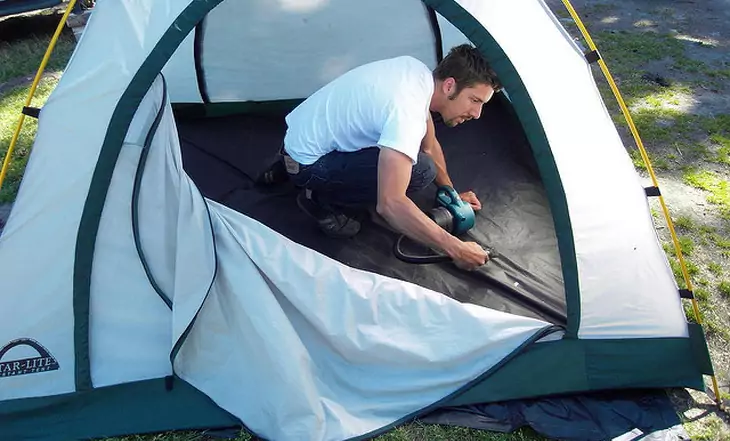
That being said, we’ve seen it necessary to equip you with the skills on how to care for your tent so that it can be more durable. Below are some tent care tips.
How to care for the tent?
We have compiled some tent care tips from how to store it to how to avoid dirt and grit on the tent floor. Caring for the tent is as equally important as knowing how to clean it.
- Setting up the tent: The area in which you pitch your tent is a contributory factor to its dirt. If pitching it on a dirty grass, with possible dust and debris, you will have created a needless job of cleaning, well, unless of course you love it. So, before setting up the tent, clear the area and remove all the dirt particles such as small rocks, debris, twigs and pine needles. Using the footprint as the custom-made ground cloth can extend the durability of your tent’s floor. It protects the floor from abrasion, and creates a clean surface to neatly pack your tools. If you’re undecided what to use, see our article on the differences between tarp and tent footprint to give you more options.
- Do not leave the tent pitched in direct sun for long: If you are going to camp for more days in the wilderness, you’re advised to pitch the tent under the shadow of your surrounding trees or mountains. The extended exposure of the UV rays will damage the waterproof coatings of the tent. The rainfly can also be degraded if overly exposed to the sun regardless of how impressive its UV resistance is. Alternatively, you can pitch in direct sunlight if it’s the only solution available and then unpack it whenever leaving the campsite for a long time just to preserve its durability.
- Only pack a dry tent after rainstorm/morning dew: If it has rained in your camping site, leave the tent pitched and taut, until it dries out completely before you can pack it. Otherwise, if mandatory to leave, dry the tent immediately after you got home before you can store it in a mesh bag or any other storage. The failure to dry it thoroughly before storage may lead to the accumulation of mold and mildew within 24 hours. The tent will eventually smell like a wet dog. If you have your dog with you, our article on backpacking tips with your pooch will help you a lot.
- Open the tent doors for adequate ventilation: No matter how intensively waterproof a tent is, there will always be a gathering of moisture in it depending on the temperature levels or the climate fluctuations. With this in mind, you have to make space for ventilation to get rid of the moisture before it leads to the unbearable mildew growth. If your tent has a large mesh area for ventilation, you can rely on it and leave opening the windows and the doors.
- Leave your hiking boots outside or store them in a vestibule: Getting into your tent without checking the sole of your boots will put it at risk of pine needles that could puncture the floor or other debris that could leave stains on the floor. You’ll then have to repair the floor or wash it immediately to remove the stains. If the tent has the vestibule, it’s better storing the outdoor shoes/boots in it.
- Leave the pets outside: No matter how lovely your pet is, leave it outside of your tent to avoid dirt on the tent fabric. The pet’s claws and teeth can also damage your beloved camping tent. So, do not leave the pets in the tent unless you’re prepared to supervise their actions.
- Air-dry the tent after every trip: Even if it had not rained on the tent, it’s important to thoroughly air-dry after your summer trip to get rid of the possible occurrence of moisture. To do this, pitch it when you get home to let the air dry it. You will also be getting rid of the odor that has been caused by the condensation. This after-trip inspection will also help spot the possibility of mildew/mold appearance so that you can remove them as early as possible.
- Store the tent loosely: We do not recommend storing the tent in a stuff sack. This stuff sack can be useful when you have to travel with the tent from one place to the other. Instead, put it in a large bag to allow more ventilation. If the tent is stored without being cleaned, for example, it can accumulate more nasty smell due top moisture. The fabrics have to breathe and relax.
- Reseal the seams and re-coat the fabrics: If the waterproof coatings have peeled off when you wash the tent, or after the rainstorm, or after a long use, the best encounter is to re-coat them. There are various seam sealant products on the market to revive the coatings at the seam in order to prevent the leakage of water inside. Note that every fabric material has got its own seam sealant material. Alternatively, you can approach the manufacturer, and ask if they can revive the water repellent coatings on your behalf. See our piece on how to seam seal a tent to prevent water from penetrating it.
- Inspect the tent continuous: The tent seams are more vulnerable to water leakage. It’s therefore important to pitch the tent at home before going out to your outdoor adventure and then sprinkle water on the tent to see if they are still functional. They can be damaged by scrubbing them vigorously. We therefore reckon that you do not scrub the seam corners roughly to avoid compromising their quality.
These are the important points to take into consideration when caring and when cleaning your tent. The best practice of preserving your tent quality is by caring for it and cleaning it accordingly.
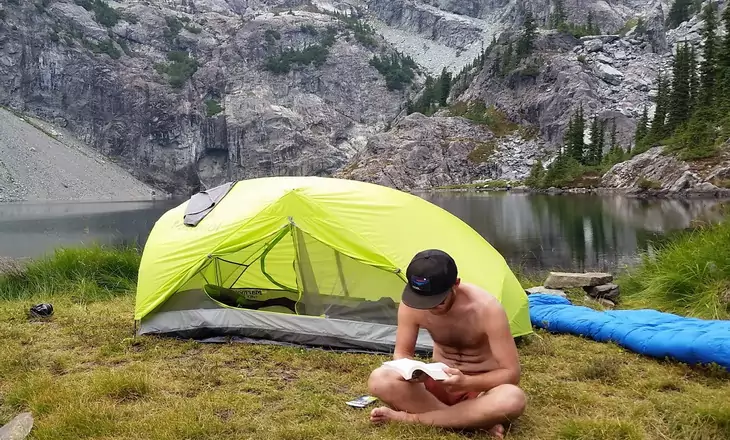
As long as you adhere to the precautionary measures before cleaning, you will then continue enjoying a fresh outdoor shelter. We’ve highlighted the precautions below.
Precautions of cleaning a tent
- Do not use detergent soaps or other strong chemicals as they can damage the fabrics
- Do not use the machine to wash the tent to avoid tearing of the fabric
- Do not store the tent while wet/damp to prevent the growth of mildew/mold
- Do not dry the tent for a long time in direct sun as the UV rays can damage the waterproof coatings
- Do not use a hair dryer to dry the tent as its heat can have an adverse effect on the fabric coatings
- Do not store the tent in a stuff sack after cleaning as it needs enough ventilation
- Do not scrub the tent vigorously
- Do not immerse the tent in water for a long time as hydrolysis may damage the waterproof coatings
Final thoughts
Cleaning a tent is an indispensable initiative that must be taken by all outdoor enthusiasts in a quest to preserve the durability. The tents that are not being cared for can end up getting damaged prematurely, and then compelling the owners to make new purchases. The sad part is that the manufacturers do not entertain the damage resulting from uncared tents.
Only factory faults are attended. It is thus your responsibility to make sure that the tent is well taken care of before and after any outdoor adventure. The tent doesn’t necessarily need vigorous or frequent cleaning sessions. Only when the need arises, that’s when you can bother to clean it.
Having provided you with the aforementioned tent care and cleaning tips, we are confident that you are now well-equipped to clean any tent on your own. These cleaning tips apply for any size of the tent and for any brand. After all it is not a hard work to clean the tent effectively as long as you adhere to the precautions and follow the steps meticulously. The other emphasized area, is the caring part of the tent. We’ve given you some insights on how to care for it in the wilderness and at home. Our cleaning tips will give answers to plenty of outdoor enthusiasts who suffered from stinking tents because of mildew or dirt.
If you’re camping with your loved ones, read our piece on top family tents to ensure an enjoyable trip.

Have you ever cleaned a tent different to the way we demonstrate? Please share with us your methods below in the comment sections. If you have any question we will be glad to respond to you as well.


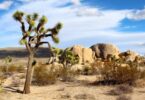
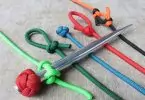




Washing our tents is perhaps the next most interesting thing we do after a going for a hike or camping expedition with my friends. Normally, we do it the morning after the hike or trip, but sometimes everyone is engaged so we have to plan a day when we all get together to clean our tents. That’s when we talk about the memorable events of our trip and even plan a new trip. We had no clue about some of the tips highlighted in this article and I believe our tents will be cleaner this way.
That is awesome! Thanks for telling us!